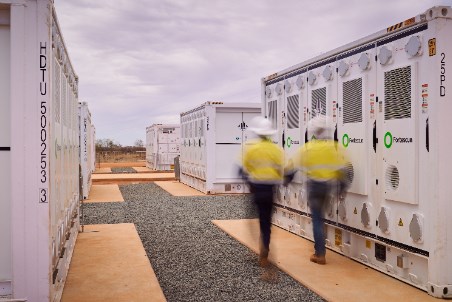Sodium-Ion Batteries: A Practical Look at a Promising Lithium Alternative – AltEnergyMag

Report on the Viability of Sodium-Ion Batteries for Sustainable Development
Introduction: Aligning Energy Storage with Sustainable Development Goals
The global transition to electric vehicles (EVs) is a critical strategy for achieving Sustainable Development Goal 13 (Climate Action) and SDG 11 (Sustainable Cities and Communities) by reducing transport-related emissions. This transition is heavily dependent on battery technology. While lithium-ion batteries currently dominate the market, their production raises significant challenges related to SDG 12 (Responsible Consumption and Production) due to the environmental and ethical concerns of lithium mining and supply chain vulnerabilities. Sodium-ion batteries are emerging as a technologically viable and sustainable alternative, offering a pathway to advance SDG 7 (Affordable and Clean Energy) by providing a more accessible and environmentally sound energy storage solution.
Comparative Analysis of Sodium-Ion and Lithium-Ion Technologies
Lithium-Ion: The Incumbent Technology and its Sustainability Challenges
Lithium-ion batteries have been optimized for decades, offering key performance advantages. However, their limitations pose risks to sustainable development objectives.
- Performance Strengths:
- High energy density (250-300 Wh/kg)
- Long cycle life (500-1000 cycles)
- Low self-discharge rate
- Sustainability and Safety Weaknesses:
- Resource Scarcity: Lithium is a finite resource concentrated in a few geographical regions, creating geopolitical risks and price volatility that challenge the “affordable” aspect of SDG 7.
- Environmental Impact: Mining processes raise environmental and ethical concerns, conflicting with the principles of SDG 12.
- Safety Risks: The use of flammable electrolytes can lead to thermal runaway, posing safety hazards.
Sodium-Ion: A Contender for Responsible and Affordable Energy
Sodium-ion technology presents a compelling alternative by directly addressing the sustainability shortfalls of lithium-ion batteries.
- Advantages for Sustainable Development:
- Resource Abundance (SDG 12): Sodium is approximately 1,000 times more abundant than lithium and is globally distributed, promoting responsible and equitable resource management.
- Lower Cost (SDG 7): With cell costs between $80-$110 per kWh, sodium-ion batteries are more affordable, increasing access to clean energy technologies like EVs.
- Enhanced Safety and Stability: Superior thermal stability and a wider operating temperature range (-30°C to 60°C) improve safety and reliability.
- Current Technological Challenges:
- Lower energy density (100-160 Wh/kg)
- Shorter cycle life compared to mature lithium-ion technology
- Underdeveloped supply and recycling chains, representing an area for development under SDG 9 (Industry, Innovation, and Infrastructure).
Technological Innovations Driving Sodium-Ion Viability (SDG 9)
Ongoing research and innovation are rapidly closing the performance gap between sodium-ion and lithium-ion batteries, directly contributing to SDG 9 by building resilient infrastructure and fostering sustainable industrialization.
Cathode Material Advancements
Cathode materials are critical for battery performance. Innovations in this area are key to creating more efficient and sustainable energy storage.
- High-Voltage Fluorophosphates: Considered a next-generation material, offering energy densities over 1,000 Wh/kg and high operating voltages, pushing the boundaries of clean energy storage.
- Sodium Vanadium Phosphate: Features a stable structure and fast ion diffusion, with research focused on enhancing its conductivity through carbon coating and doping.
- Sulfate-Based Cathodes: Utilize abundant and low-cost elements like iron and sulfur, aligning perfectly with SDG 12 by reducing reliance on scarce materials.
- Prussian Blue Analogues (PBAs): A highly researched area due to low cost and an open framework that facilitates rapid sodium-ion movement. Current research aims to overcome structural instability through defect engineering and doping.
Anode Material Development
Anode innovations are focused on increasing charge capacity and cycle life, essential for durable and reliable contributions to SDG 7 and SDG 11.
- Carbon-Based Anodes: Hard carbon is the most commercially viable anode material, offering stable cycling performance and a capacity of 250-400 mAh/g. Its flexible structure is well-suited for sodium storage.
- Transition Metal Sulfides and Phosphorus-Based Anodes: These materials offer exceptionally high theoretical capacity but face challenges with volume expansion. Nanostructuring and composite designs are being developed to enhance their stability and viability for industrial application.
Electrolyte System Innovations
The development of safer and more efficient electrolytes is crucial for the widespread adoption of sodium-ion batteries.
- Liquid Electrolytes: Offer high ionic conductivity but pose safety risks due to flammable solvents.
- Solid-State Electrolytes: A key area of innovation, these non-flammable materials eliminate leakage and thermal runaway risks, significantly improving battery safety.
- Polymer and Composite Electrolytes: These systems combine the safety of solids with the flexibility of polymers. Hybrid polymer-ceramic electrolytes are emerging as a leading candidate, offering high conductivity, flexibility, and thermal stability for future EV batteries.
Conclusion: The Role of Sodium-Ion Batteries in a Sustainable Future
Sodium-ion batteries represent a significant advancement in energy storage technology, with a profile that strongly aligns with the United Nations Sustainable Development Goals. By leveraging abundant, low-cost materials, this technology supports SDG 7 (Affordable and Clean Energy) and SDG 12 (Responsible Consumption and Production). Continuous innovation in battery components, driven by SDG 9, is steadily improving performance and safety. As a result, sodium-ion technology is poised to complement and, in certain applications, replace lithium-ion batteries, thereby accelerating the global transition to sustainable transportation and helping to achieve critical climate targets under SDG 13.
Analysis of Sustainable Development Goals in the Article
1. Which SDGs are addressed or connected to the issues highlighted in the article?
-
SDG 7: Affordable and Clean Energy
The article focuses on developing sodium-ion batteries as a more affordable energy storage solution for electric vehicles (EVs). By presenting a technology that is “cheaper” and uses more abundant materials, it directly addresses the goal of making clean energy technologies more accessible and affordable. EVs are a cornerstone of clean energy in the transport sector.
-
SDG 9: Industry, Innovation, and Infrastructure
The text is a comprehensive review of “ongoing innovations” in battery technology, from “high-voltage cathodes” and “hard carbon anodes” to “advanced polymer electrolytes.” It discusses upgrading industrial capabilities by developing alternatives to lithium-ion technology and highlights the need to build “supply chains” for sodium-ion batteries, which relates to developing sustainable and resilient infrastructure.
-
SDG 12: Responsible Consumption and Production
A central theme of the article is the shift towards more sustainable production patterns. It contrasts the “ethical and environmental concerns” of lithium mining with sodium, which is described as “more environmentally sustainable” due to its abundance and wider geographical distribution. This directly aligns with the goal of achieving sustainable management and efficient use of natural resources.
-
SDG 13: Climate Action
The article explicitly states that “Electric vehicles (EVs) are a major step toward reducing global emissions.” By exploring advancements in battery technology that can accelerate the adoption of EVs, the article directly connects to urgent action to combat climate change. The development of more cost-effective and sustainable batteries is critical for the decarbonization of the transport sector.
2. What specific targets under those SDGs can be identified based on the article’s content?
-
Target 7.a: “By 2030, enhance international cooperation to facilitate access to clean energy research and technology… and promote investment in energy infrastructure and clean energy technology.”
The article itself, being a review of the “latest research,” contributes to the dissemination of knowledge on clean energy technology. It discusses the work of companies like “CATL and Faradion” driving “large-scale development,” which points to investment and research in this field.
-
Target 9.4: “By 2030, upgrade infrastructure and retrofit industries to make them sustainable, with increased resource-use efficiency and greater adoption of clean and environmentally sound technologies…”
The development of sodium-ion batteries represents an adoption of a “clean and environmentally sound” technology. The article notes that these batteries “share similar electrochemistry with lithium-ion batteries, making them compatible with existing battery manufacturing processes,” which relates to retrofitting and upgrading industrial processes for sustainability.
-
Target 9.5: “Enhance scientific research, upgrade the technological capabilities of industrial sectors… encouraging innovation…”
The entire article is dedicated to detailing scientific research and technological advancements in sodium-ion batteries. It covers innovations in “Cathode,” “Anode,” and “Electrolyte” materials, demonstrating a clear focus on enhancing research to solve technological challenges like energy density and cycle life.
-
Target 12.2: “By 2030, achieve the sustainable management and efficient use of natural resources.”
The article’s primary argument is based on this target. It advocates for using sodium, which is “~1,000 times more common than lithium” and “far more abundant and geographically widespread,” to “reduce dependence on scarce lithium resources.” This is a direct call for more sustainable management of natural resources in the battery industry.
3. Are there any indicators mentioned or implied in the article that can be used to measure progress towards the identified targets?
- Cost of energy storage technology: The article provides a specific cost metric, stating that “Sodium-ion cells currently cost $80-$110 per kWh, cheaper than lithium-ion.” This is a direct indicator for measuring the affordability of clean energy technology (SDG 7).
- Performance and efficiency metrics: The article lists several technical indicators that measure the progress of the technology, such as energy density (“100-160 Wh/kg” for sodium-ion vs. “250-300 Wh/kg” for lithium-ion), cycle life, and operating temperature range (“-30°C to 60°C”). These metrics are crucial for tracking innovation and technological capability (SDG 9).
- Resource abundance and dependency: The article uses the relative abundance of sodium (“~1,000 times more common than lithium”) as a key indicator of its sustainability. Reducing dependency on a scarce resource like lithium is an implied indicator for measuring progress towards sustainable resource management (SDG 12).
- Price stability of raw materials: The article highlights the “extreme price swings” of lithium carbonate as a major issue. The implication is that the stable and lower cost of sodium is an indicator of a more sustainable and resilient supply chain (SDG 12).
- Adoption of clean technologies: The article’s central question of whether “sodium-ion batteries can realistically replace, or at least complement, lithium-ion batteries in EVs” implies that the market share and adoption rate of this new technology is a key indicator of progress towards climate goals (SDG 13) and sustainable industry (SDG 9).
4. Summary Table of SDGs, Targets, and Indicators
| SDGs | Targets | Indicators |
|---|---|---|
| SDG 7: Affordable and Clean Energy | 7.a: Facilitate access to clean energy research and technology. | Cost of energy storage technology (e.g., “$80-$110 per kWh” for sodium-ion cells). |
| SDG 9: Industry, Innovation, and Infrastructure | 9.4: Upgrade industries to be sustainable and adopt clean technologies. 9.5: Enhance scientific research and encourage innovation. |
Performance metrics of the technology (e.g., energy density in Wh/kg, cycle life). Compatibility with existing manufacturing processes. |
| SDG 12: Responsible Consumption and Production | 12.2: Achieve sustainable management and efficient use of natural resources. | Relative abundance of raw materials (e.g., Sodium is “~1,000 times more common than lithium”). Price stability of resources (vs. “extreme price swings” of lithium). |
| SDG 13: Climate Action | 13.2: Integrate climate change measures into policies and planning. | Adoption rate of EVs powered by sustainable battery technology as a measure for “reducing global emissions.” |
Source: altenergymag.com
What is Your Reaction?
 Like
0
Like
0
 Dislike
0
Dislike
0
 Love
0
Love
0
 Funny
0
Funny
0
 Angry
0
Angry
0
 Sad
0
Sad
0
 Wow
0
Wow
0




















































.jpg.webp?itok=0ZsAnae9#)


























